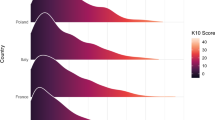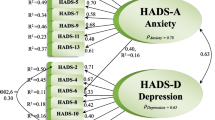Abstract
Purpose
The Hospital Anxiety and Depression Scale (HADS) is widely used in both research and clinical contexts. However, UK normative data from HADS remain limited. In our recent review of the literature, only six reports from four studies were identified as reporting UK normative data and all had limitations. The aim of our study was to use a large population-based dataset to address this.
Methods
The Epidemiology of Functional Disorders Study is a large longitudinal population-based study carried out in Northwest England. All adults aged between 25 and 65 years registered with three general practices were sent a self-completion questionnaire which contained the HADS and other health-related instruments. Scores were calculated for participants completing all items on each sub-scale (anxiety 6,189 participants and depression 6,198 participants). Scores are presented by gender and by 5-year age groups. Percentile scores were also generated.
Results
The median anxiety score was higher in women [6, interquartile range (IQR) 4–9] than in men (5, IQR 2–8) and increased with age in both groups. The median depression score for both women and men was 3 (IQR 1–6).
Conclusions
Our study is the largest population-based study providing UK normative data from the HADS. While our data confirm some of the normative data reported previously, subtle and important differences emerged, particularly at the upper end of the percentile scores. Due to the nature of our study design and the number of participants sampled, we believe that our data are likely to be more representative of the UK population than existing published normative values.


Similar content being viewed by others
References
Fitzpatrick, R., Davey, C., Buxton, M., & Jones, D. (1998). Evaluating patient-based outcome measures for use in clinical trials. Health Technology Assessment, 2(14), 1–86.
Department for Health. (2008). Guidance on the routine collection of Patient Reported Outcome Measures (PROMs). www.dh.gov.uk/publications.
Schmidt, L. J., Garratt, A. M., & Fitzpatrick, R. (2000). Instruments for Mental Health: A review. Report from the Patient-reported Health Instruments Group (formerly the Patient-assessed Health Outcomes Programme) to the Department of Health.
Zigmond, A. S., & Snaith, R. P. (1983). The Hospital Anxiety and Depression Scale. Acta Psychiatrica Scandinavica, 67, 361–370.
Snaith, R. P. (2003). The Hospital Anxiety and Depression Scale. Health Qual Life Outcomes, 1, 29–32.
Hermann, C. (1997). International experiences with the Hospital Anxiety and Depression Scale—A review of validation data and clinical results. Journal of Psychosomatic Research, 42(1), 17–41.
Bjelland, I., Dahl, A. A., Haug, T. T., & Neckelmann, D. (2002). The validity of the Hospital Anxiety and Depression Scale: An updated literature review. Journal of Psychosomatic Research, 52, 69–77.
Dowell, A. C., & Biran, L. A. (1990). Problems in using the hospital anxiety and depression scale for screening patients in general practice. The British Journal of General Practice, 40, 27–28.
Lisspers, J., Nygren, A., & Sodermann, E. (1997). Hospital Anxiety and Depression Scale (HAD): Some psychometric data for a Swedish sample. Acta Psychiatrica Scandinavica, 96, 281–286.
Spinhoven, P. H., Ormel, J., Sloekers, P. A., Kempen, G. I. J. M., Speckens, A. E. M., & Van Hemert, A. M. (1997). A validation study of the Hospital Anxiety and Depression Scale (HADS) in different groups of Dutch subjects. Psychological Medicine, 27, 363–370.
Groenvold, M., Fayers, P. M., Sprangers, M. A. G., Bjorner, J. B., Klee, M. C., Aaronson, N. K., et al. (1999). Anxiety and depression in breast cancer patients at low risk of recurrence compared with the general population: A valid comparison? Journal of Clinical Epidemiology, 52(6), 523–530.
Dunbar, M., Ford, G., Hunt, K., & Der, G. (2000). A confirmatory factor analysis of the Hospital Anxiety and Depression Scale: Comparing empirical and theoretically derived structures. British Journal of Clinical Psychology, 39, 79–94.
Stordal, E., Bjartveit Krüger, M., Dahl, N. H., Krüger, Ø., Mykletun, A., & Dahl, A. A. (2001). Depression in relation to age and gender in the general population: the Nord-Trøndelag Health Study (HUNT). Acta Psychiatrica Scandinavica, 104, 210–216.
Kadam, U. T., Croft, P., & Lewis, M. (2001). Use of a cross-sectional survey to estimate outcome of health care: The example of anxiety and depression. Journal of Clinical Epidemiology, 54, 1112–1119.
Crawford, J. R., Henry, J. D., Crombie, C., & Taylor, E. P. (2001). Normative data for the HADS from a large non-clinical sample. British Journal of Clinical Psychology, 40, 429–434.
Beutel, M. E., Wiltink, J., Schwarz, R., Weidner, W., & Brähler, E. (2002). Complaints of the ageing male based on a representative community sample. Euro Urology, 41, 85–93.
Bjelland, I., Tell, G. S., Vollset, S. M., Refsum, H., & Ueland, P. M. (2003). Folate, vitamin B12, homocysteine, and the MTHFR 677C→T polymorphism in anxiety and depression. Archives of General Psychiatry, 60, 618–626.
Beutel, M. E., Weidner, K., Schwarz, R., & Brähler, E. (2004). Age-related complaints in women and their determinants based on a representative community study. European Journal of Obstetrics, Gynecology, and Reproductive Biology, 117, 204–212.
Berg, A. M., Hem, E., Lau, B., & Ekeberg, Ø. (2006). An exploration of job stress and health in the Norwegian police service: A cross-sectional study. Journal of Occupational Medicine and Toxicology, 1, 26–34.
Mutrie, N., & Hannah, M. K. (2007). The importance of both setting and intensity of physical activity in relation to non-clinical anxiety and depression. International Journal of Health Promotion and Education, 45(1), 24–32.
Kilkkinen, A., Kao-Philpot, A., O’Neil, A., Philpot, B., Reddy, P., Bunker, S., et al. (2007). Prevalence of psychological distress, anxiety and depression in rural communities in Australia. Australian Journal of Rural Health, 15, 114–119.
Welén, K., Faresjö, A., & Faresjö, T. (2008). Functional dyspepsia affects women more than men in daily life: A case–control study in primary care. Gender Medicine, 5(1), 62–73.
Michopoulos, I., Douzenis, A., Kalkavoura, C., Christodoulou, C., Michalopoulou, P., Kalemi, G., et al. (2008). Hospital Anxiety and Depression Scale (HADS): Validation in a Greek general hospital sample. Annals of General Psychiatry, 7, 4–8.
Crawford, J. R., Garthwaite, P. H., Lawrie, C. J., Henry, J. D., MacDonald, M. A., Sutherland, J., et al. (2009). A convenient method of obtaining percentile norms and accompanying interval estimates for self-report mood scales (DASS, DASS-21, HADS, PANAS, and sAD). British Journal of Clinical Psychology, 48(Pt2), 163–180.
Bouwman, V., Adriaanse, M. C., van’t Riet, E., Snoek, F. J., Dekker, J. M., & Nijpels, G. (2010). Depression, anxiety and glucose metabolism in the general Dutch population: The New Hoorn Study. PLoS ONE, 5(4), e9971.
Michal, M., Glaesmer, H., Zwerenz, R., Wiltink, J., Brahler, E., & Beutel, M. E. (2011). Base rates for depersonalization according to the 2-item version of the Cambridge Depersonalization Scale (CDS-2) and its association with depression/anxiety in the general population. Journal of Affective Disorders, 128(1–2), 106–111.
Hinz, A., & Brahler, E. (2011). Normative values for the hospital anxiety and depression scale (HADS) in the general German population. Journal of Psychosomatic Research, 71(2), 74–78.
McBeth, J., Chiu, Y. H., Silman, A. J., Ray, D., Morriss, R., Dickens, C., et al. (2005). Hypothalamic–pituitary–adrenal stress axis function and the relationship with chronic widespread pain and its antecedents. Arthritis Research & Therapy, 7(5), R992–R1000.
McBeth, J., Silman, A. J., Gupta, A., Chiu, Y. H., Ray, D., Morriss, R., et al. (2007). Moderation of psychosocial risk factors through dysfunction of the hypothalamic–pituitary–adrenal stress axis in the onset of chronic widespread musculoskeletal pain. Arthritis and Rheumatism, 56(1), 360–371.
Townsend, P., Phillimore, P., & Beattie, A. (1988). Health and deprivation: Inequalities and the north. London: Croom Helm.
The 2001 Census was carried out in April 2001 by the Office of National Statistics. http://www.statistics.gov.uk/census2001/pyramids/pages/uk.asp. Accessed on June 11, 2010.
Jones, E. A., McBeth, J., Nicholl, B., Morriss, R. K., Dickens, C., Jones, G. T., et al. (2009). What characterises persons who do not report musculoskeletal pain? Results from a four-year population-based longitudinal study (The Epifund Study). Journal of Rheumatology, 36(5), 1071–1077.
NHS The Information Centre. Attribution dataset GP registered populations 2010. http://www.ic.nhs.uk/statistics-and-data-collections/population-and-geography/gp-registered-populations/attribution-dataset-gp-registered-populations-2010. Accessed on September 29, 2011.
World Health Organisation website. http://www.who.int/topics/ageing/en/. Accessed on April 12, 2010.
de Wit, L. M., Fokkema, M., van Straten, A., Lamers, F., Cuijpers, P., & Penninx, B. W. (2010). Depressive and anxiety disorders and the association with obesity, physical, and social activities. Depression and Anxiety, 27, 1057–1065.
Acknowledgments
The authors would like to thank all those involved in the EpiFunD study for their role in collecting the data used in this study, particularly the principal investigators Gary Macfarlane (University of Aberdeen) and John McBeth (Keele University, and the University of Manchester) who allowed use of the EpiFunD dataset. The EpiFunD study was funded by Arthritis Research UK (formerly the Arthritis Research Campaign), Grant Number: 17552.
Author information
Authors and Affiliations
Corresponding author
Rights and permissions
About this article
Cite this article
Breeman, S., Cotton, S., Fielding, S. et al. Normative data for the Hospital Anxiety and Depression Scale. Qual Life Res 24, 391–398 (2015). https://doi.org/10.1007/s11136-014-0763-z
Accepted:
Published:
Issue Date:
DOI: https://doi.org/10.1007/s11136-014-0763-z




